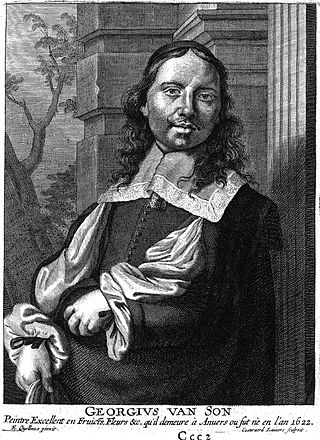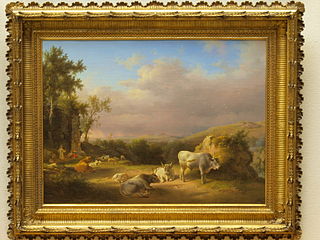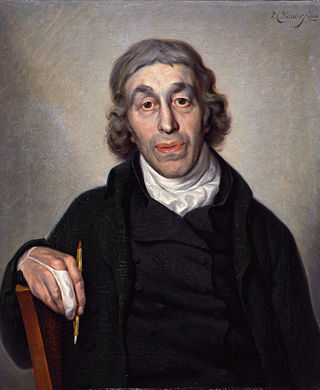Related Research Articles

Ambrosius Bosschaert the Elder was a Flemish-born Dutch still life painter and art dealer. He is recognised as one of the earliest painters who created floral still lifes as an independent genre. He founded a dynasty of painters who continued his style of floral and fruit painting and turned Middelburg into the leading centre for flower painting in the Dutch Republic.
Aelbert Jacobszoon Cuyp or Cuijp was one of the leading Dutch Golden Age painters, producing mainly landscapes. The most famous of a family of painters, the pupil of his father, Jacob Gerritszoon Cuyp (1594–1651/52), he is especially known for his large views of Dutch riverside scenes in a golden early morning or late afternoon light. He was born and died in Dordrecht.

CasparNetscher was a Dutch portrait and genre painter. He was a master in depicting oriental rugs, silk and brocade and introduced an international style to the Northern Netherlands.

Abraham van Diepenbeeck was Dutch painter, draftsman, glass painter, print maker and tapestry designer who worked most of his active career in Antwerp. He designed glass windows for various churches and monasteries in Antwerp for which he made many design drawings and oil sketches. He engraved and designed many prints which were published by prominent Antwerp printers such as van Meurs, the Plantin Press and Martinus van den Enden the Elder. He had a close relationship with the workshop of the leading Flemish Baroque painter Peter Paul Rubens and collaborated on various projects under the direction of Rubens. In the 1630s van Diepenbeeck started to create monumental paintings. His work was influenced by Rubens and Anthony van Dyck.
Joris, a Dutch form of the given name George, may refer to:
Events from the year 1615 in art.
Events from the year 1669 in art.
Events from the year 1587 in art.

Aert Schouman or Aart Schouman was an 18th-century painter, now better known as a glass engraver, from the Dutch Republic.

Abraham van Calraet, or Kalraat was a Dutch Golden Age still-life, portrait- and landscape painter.

Joris van Schooten (1587–1651) was a Dutch Golden Age painter and the uncle of the Leiden mathematician Frans van Schooten.

Joris Abrahamsz. van der Haagen was a Dutch Golden Age painter specialized in landscapes.

Joris van Son or Georg van Son was a Flemish still life painter who worked in a number of sub-genres but is principally known for his still lifes of fruit. He also painted flowers, banquets, vanitas still lifes and pronkstillevens. He is known to have painted fish still lifes representing the Four Elements, and also collaborated with figure artists on 'garland paintings', which typically represent a devotional image framed by a fruit or flower garland.

Abraham Diepraam, or Diepraem, was a Dutch Golden Age painter.

Isaac van Duynen also known as Deynen or Duijnen was a Dutch still life painter. He is known for still lifes of dead fish and other sea animals, still lifes with fruit, banquet still lifes and the occasional kitchen scene.

Abraham Teerlink - Rome, 26 May 1857 or July 1857) was a 19th-century painter and draughtsman from the Netherlands.

Abraham van Strij (1753–1826) was an 18th-century painter from the Netherlands.

Jacob van Strij was a Dutch painter, printmaker, and draftsman who was mainly interested in landscape painting, including mountain landscapes, winter landscapes and marines.
Van der Hagen is a Dutch-language toponymic surname, meaning "from/of the "haag". A haag was a bushland, hedged lot, or (private) hunting ground. The name could also specifically refer to an origin in The Hague. Some variant spellings of the name are Van der Haagen, Van der Haegen, Van der Haeghen, Van der Hage, and Van der Haghen. People with such names include:
References
- ↑ "Haagen, Abraham van der" (in Dutch). Nieuw Nederlandsch Biografisch Woordenboek (NNBW), accessed via Resources Huygens ING. Retrieved 19 February 2014.
- 1 2 Abraham van der Haagen in the RKD
- ↑ Bisanz-Prakken, Marian (2005). Rembrandt and His Time: Masterworks from the Albertina, Vienna. Hudson Hills. p. 164. ISBN 978-1-55595-257-0.